The Tragedy
On August 11, 1921, life drastically changed for one man but he never let the world know of his misfortune. On this particular morning, in Campobello Island, off the coast of Maine, Franklin D. Roosevelt (FDR) got out of bed and attempted to make it to the bathroom. The day before he was sailing and swimming. His legs began to ache and he developed an uncontrollable shiver. As a result of his condition, he went to bed early. When he woke, FDR had a fever of 102 and he struggled across the hall. His left leg collapsed beneath him. Soon thereafter, he was diagnosed with polio.
In a detailed letter written to Dr. William Egleston of Hartsville, South Carolina, on October 11, 1924, FDR described what it was like to be suddenly attacked by polio.1
“First symptoms of the illness appeared in August, 1921, when I was thoroughly tired from overwork. I first had a chill in the evening which lasted practically all night. The following morning the muscles of the right knee appeared weak by afternoon. I was able to support my weight on my right leg. That evening the left knee began to weaken also and by the following morning I was unable to stand up. This was accompanied by a continuing temperature of about 102 and I felt thoroughly achy all over. By the end of the third day practically all muscles from the chest down were involved. Above the chest the only symptom was a weakening of the two large thumb muscles making it impossible to write. There was a special pain along the spine and no rigidity of the neck.” – FDR.
The letter was written by FDR as a response to Dr. Egleston’s request for information regarding his condition. FDR is very detailed and provides “Do and Don’ts,” for the doctor to consider during treatment for patients with polio. FDR further reported that his first braces were made of, “steel weighted 7lbs apiece-my new ones weigh only 4lbs apiece.” This was because his second pair was made of “duraluminum.”
This detailed letter outlines FDR’s experience with exercising in a swimming pool. FDR reported he began swimming in the summer of 1922. He found, “this exercise seemed better adapted than any other because all the weight was removed from the legs and I was able to move the legs in the water far better than I had expected.” Thereafter, FDR began to exercise in water. This would lead him to his greatest and most precious discovery; Warm Springs, Georgia and the Little White House.
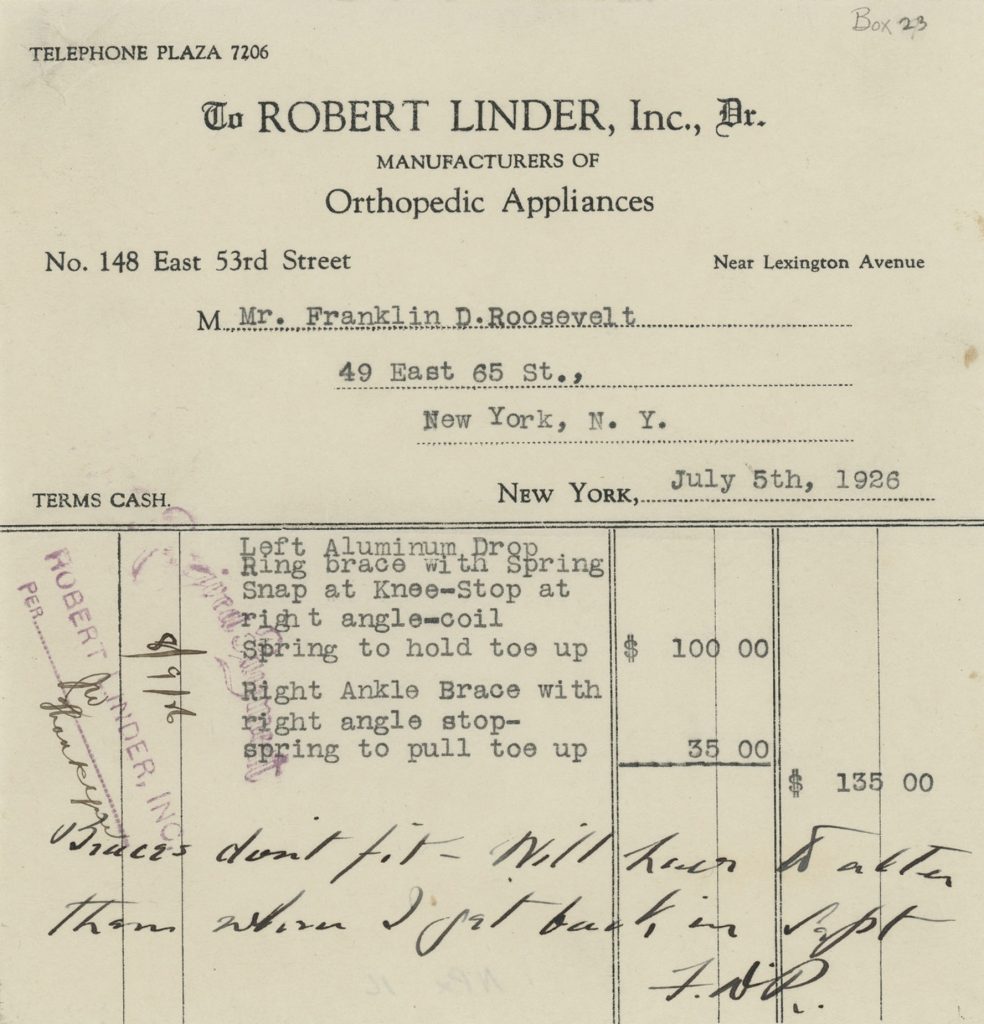
An invoice for FDR’s right braces. The cost in 1926 was $135.00. FDR’s handwritten note reflecting the braces did not fit.
Discovery of Warm Springs
FDR first visited Warm Springs, Georgia on October 3, 1924. He had been battling with the symptoms of polio for a little over three years. He swam consistently for two weeks and reported he was able to stand in four feet of water, something he could not do for the past three years.
During his first visit, FDR explored the countryside and attended town meetings. It was here that FDR was exposed to “rural southern poverty” and was deeply moved. A reporter from the Atlanta Journal traveled to Warm Springs to uncover what the former Assistant to the Navy and Vice Presidential candidate was doing in such a rural area. FDR agreed to an interview. It was during this interview FDR revealed he was suffering from polio. However, he never discussed how polio drastically changed his life. Instead, he talked about his rehabilitation.
FDR reported he was able to move his right leg for the first time in three years and commented on the beauty of the area. FDR also said he was thankful of the hospitality he received. One part of the article that caught the public off guard contained pictures of FDR’s shriveled legs. After all, he downplayed the impact the disease took on his body. The article was also published in the October 26, 1924, issue of Sunday Magazine and was syndicated nationally.
Because of this publicity, people afflicted with polio across the nation began arriving in Warm Springs to experience was Roosevelt called, “the Spirit of Warm Springs.” The success of Warm Springs made FDR open a polio therapeutic treatment center called the Georgia Warm Springs Foundation in 1926.
In a letter written on April 6, 1927, from FDR to Julian Hawthorne, FDR reported on the progress they were making on the Foundation. He wrote,
“Things are coming along well and the new Patient’s Pool is about ready. There is no question that we shall have many more applications from patients than we have accommodations for, and the only trouble is that so many of them are really poor people who cannot afford to pay the actual cost of $42 a week. I am starting a Patients’ Aid Fund to help these poor children and hope to be able to assist about 15 out of the 50 patients.”
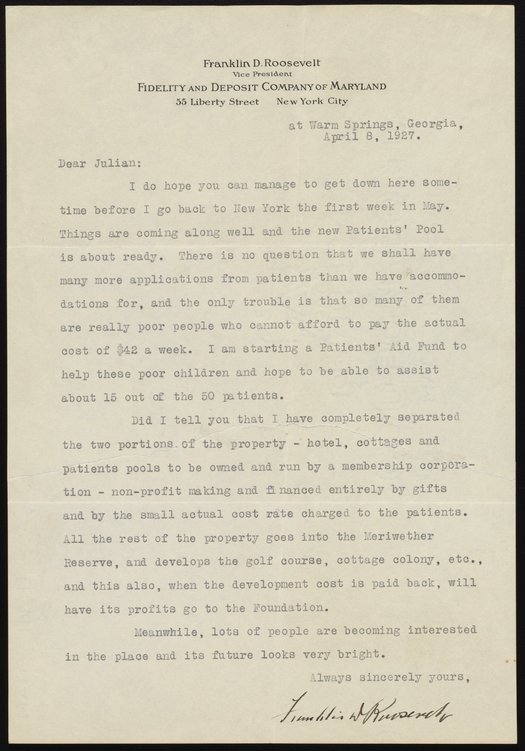
Roosevelt’s Little White House
Although he looked for a cure for his paralysis, FDR never gained use of his legs, confining him to a wheel chair or crutches. However, by 1928 FDR regained enough strength, confidence, and composure, to return to his greatest passion, politics. He soon found himself in the Governor’s mansion in Albany, New York, and this cleared a path to the White House.
In 1932, the small cottage in Warm Springs, Georgia, which is today affectionately known as, “Roosevelt’s Little White House” was completed. On May 5, 1932, FDR decided to have a housewarming party to celebrate his retreat. FDR invited all the local inhabitants by telephone and placed a bulletin in the local papers inviting those who did not have the luxury of a telephone.
The Structure
The building is very modest and meek. It contains only six rooms and is single story. In fact upon the approach, with the exception of a four-columned entranceway, one would think that someone of little importance resided within its walls.
The living room is combined with a humble dinning room. However, looking into the living room section of this giant room, one cannot wonder or imagine the many conversations, the many guests, and the many sleepless nights FDR must have had. His leather chair, with his leather desk, makes one wonder what this great leader thought about, wrote about, and pondered. The room is littered with pictures and models of sailing ships. A pastime FDR loved.
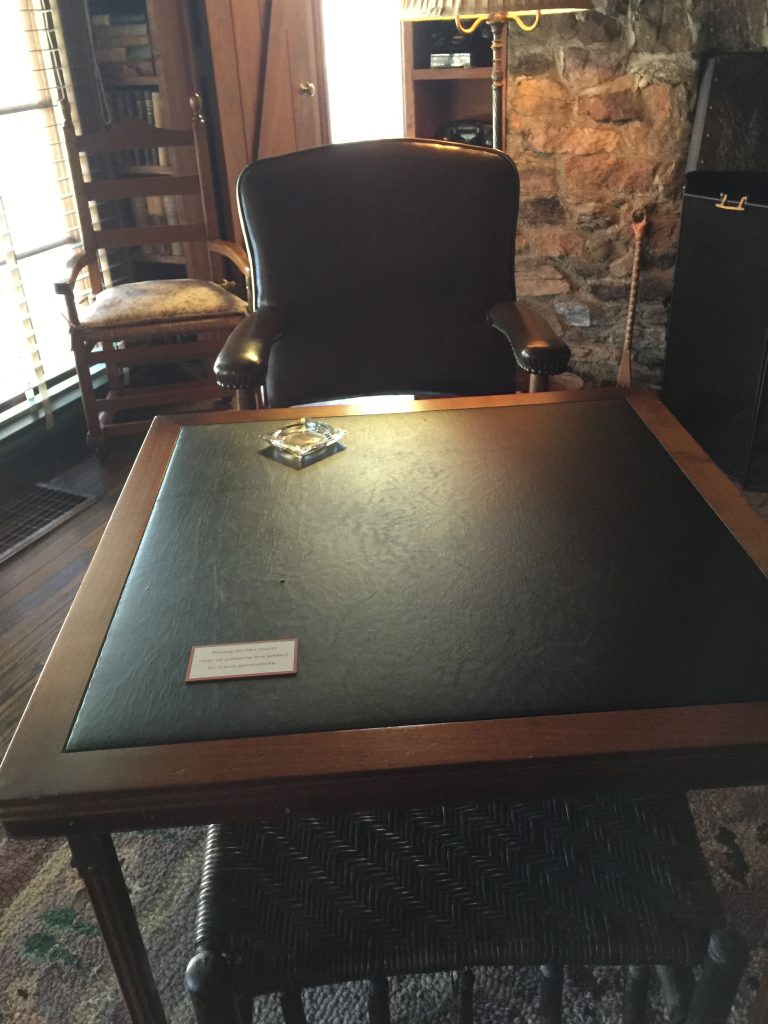
FDR’s working desk in the living room of Roosevelt’s Little White House.
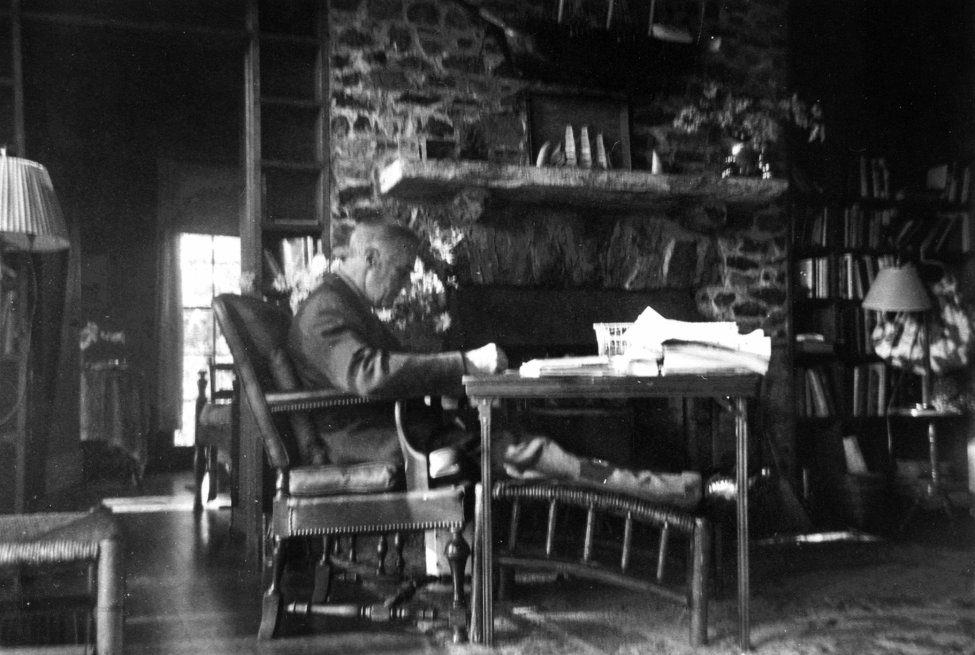

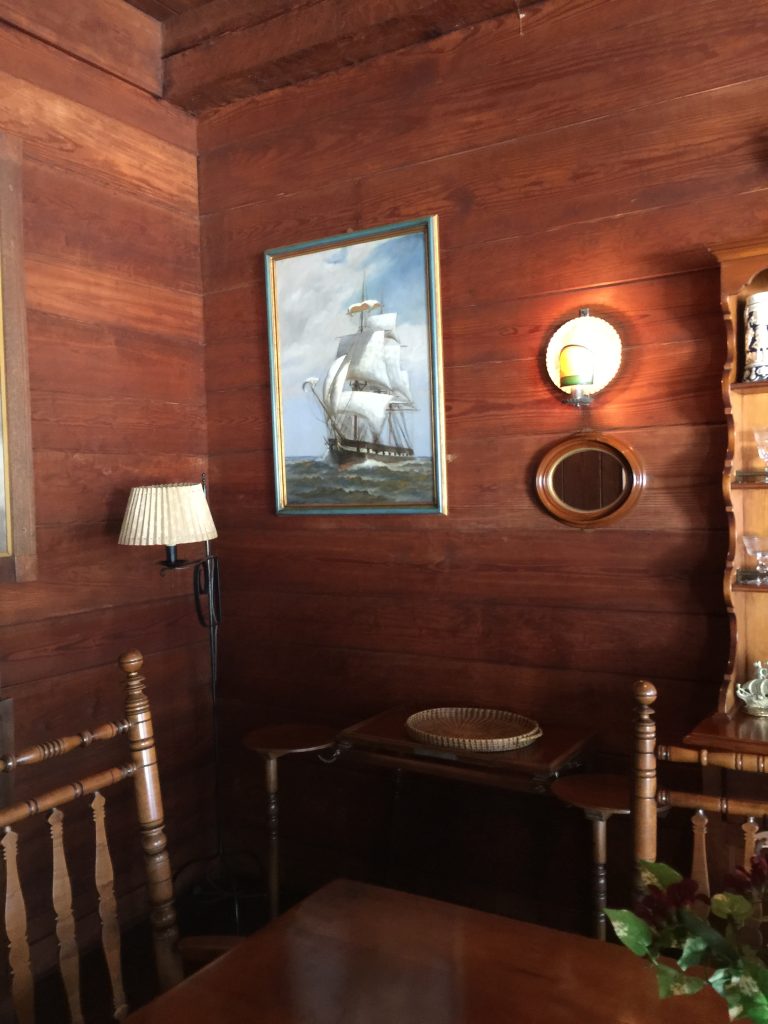
Images from Inside Roosevelt’s Little White House
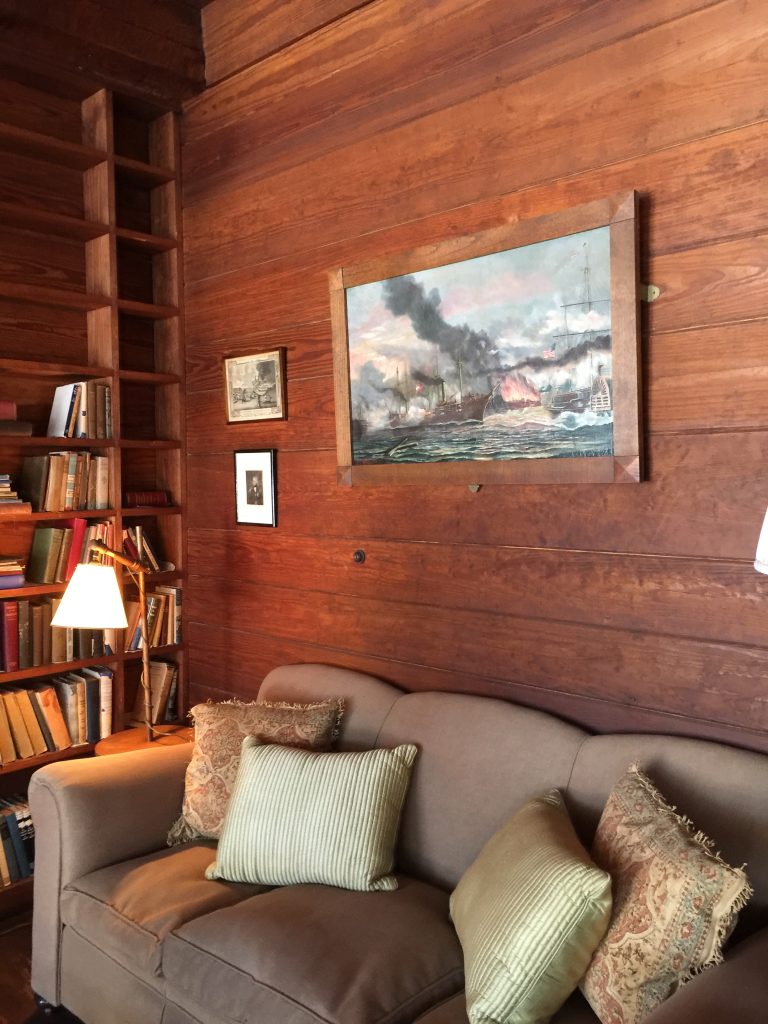
The living room empties onto a sundeck by way of highly placed French doors. The sundeck overlooks a wooded ravine. There are many pictures throughout FDR’s Governorship and Presidency that captures FDR on this sundeck, pulled up near a table with a pile of papers to review. In other pictures, you can see FDR’s enjoyment of the solitude this house provided.

From the sundeck, FDR could go directly into his bedroom. The bedroom is also furnished very modestly; a bed, a desk, a side table, and a chest of draws. The desk is oversized for the room. His chair appears specially made to assist with his disabilities. His bed seems almost too small for a man of FDR’s size.

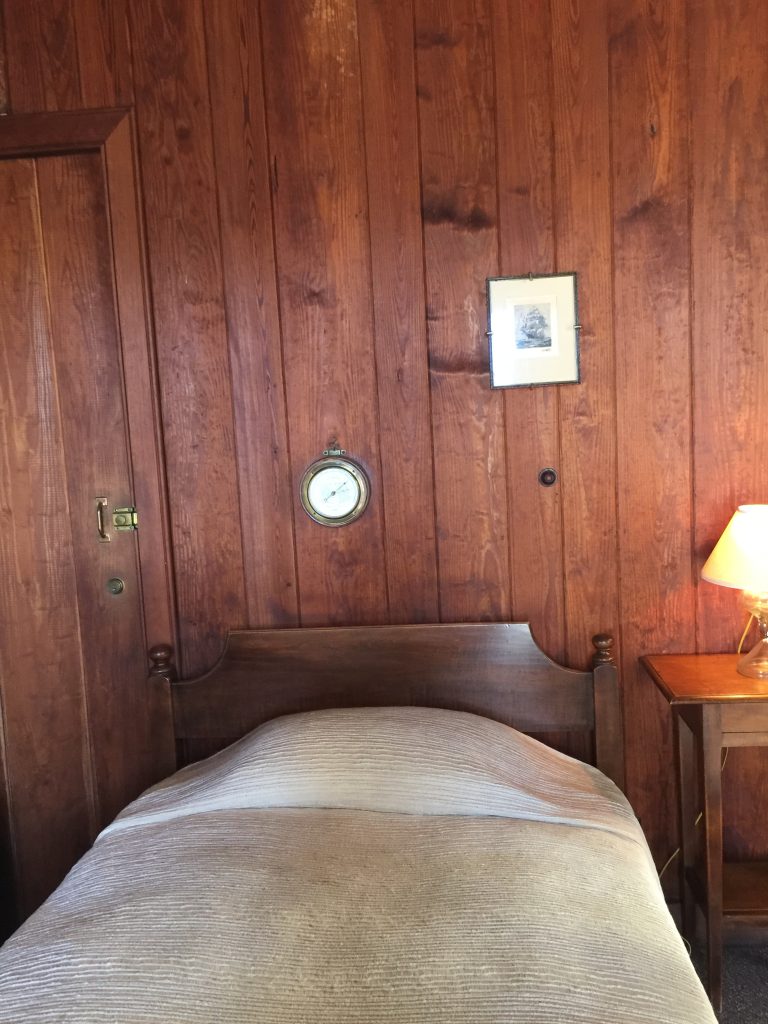
Yet however small or modest this bedroom was, on April 12, 1945, it became larger than the United States. While he was posing for a portrait by Madame Elizabeth Shoumatoff, FDR suffered a stroke and collapsed. He was taken to this very room and at 3:35 p.m., the nation’s 32nd President was pronounced dead.
Madame Shoumatoff never finished the painting and it has since been named the “Unfinished Portrait.” The man who led us through the Great Depression, World War II, and restored confidence in America was no longer. The “Unfinished Portrait” is displayed at the museum located on the grounds of Roosevelt’s Little White House, exactly as Madame Shoumatoff left it.
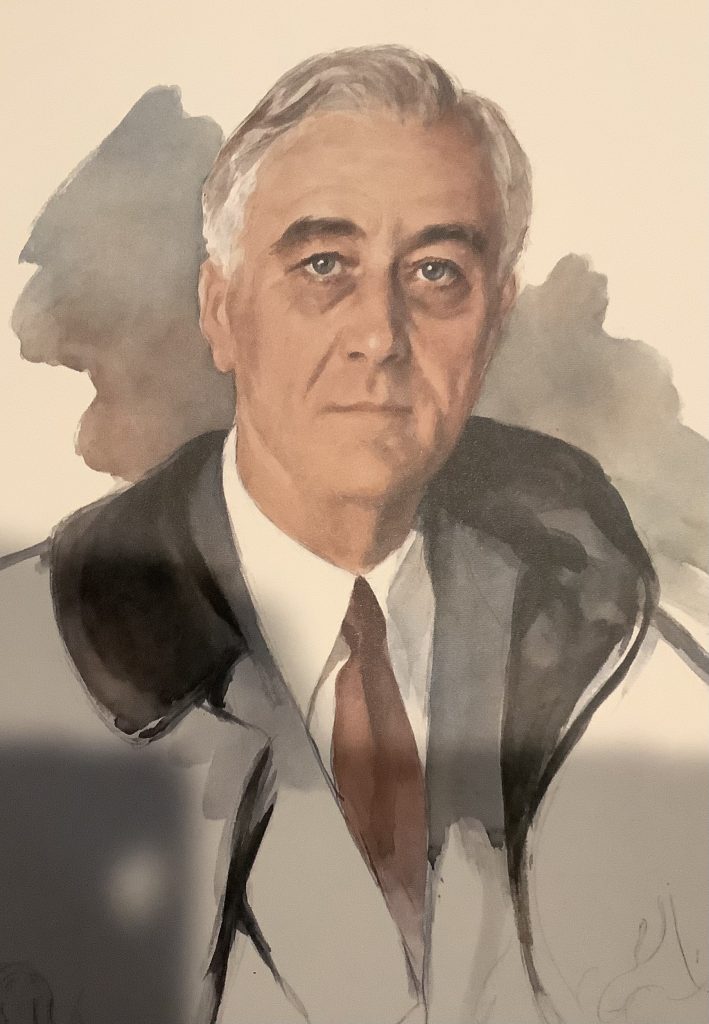
There is a flag outside the Little White House. The flag has the standard 13 strips. However, it contains only 48 stars. At the time of his death, neither Alaska nor Hawaii was part of the United States. Today, we have 50 stars representing 50 states, a testament to FDR. It was because of his courage, strength, and resolve that we continued to grow as a nation.
Endnote:
- The entire letter can be viewed at – www.archives.gov/research/americans-with-disabilities/transcriptions/naid-6037479-letter-from-fdr-to-dr-egleston.html
Leave a Reply